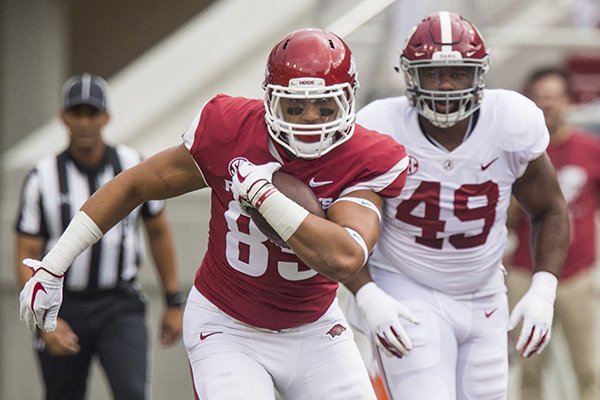LITTLE ROCK — Originated by a British real estate tycoon and employed by a long-term game show host in insurance commercials, repeating a word three times to make an unequivocal point also works when addressing the needs of Arkansas football.
The late Lord Harold Samuel is credited with saying: “There are three things that matter in property - location, location, location.”
These days, “Jeopardy” host Alex Trebek hawks life insurance at $9.95 per unit for one and all touting, “price, price, price.”
As for the Razorbacks, shortcomings at specific positions heading into spring practice play second fiddle to, “speed, speed, speed.”
In today’s game, with offenses spread all over the field, if a player can’t run, he can’t succeed. Everywhere on defense and at the skill positions on offense, speed is a must.
And, “speed,” is a bit vague. We’re really talking about football fast, not simply an athlete who clocked four-point-something sprinting straight ahead for 40 yards.
More meaningful is how quickly defensive players recognize what is happening, react by taking appropriate pursuit angles and close on the ball carrier. Back in the day, such athletes were often described as having a “nose for the football.”
Although an unfair blanket indictment of all Arkansas’ returning defensive starters, such plays were few and far between in 2018.
Jimmy Johnson at Miami and Bobby Bowden at Florida State were among the first to put fast first. Between 1986 and 1993, each won a national championship and recorded seven top-five finishes in the polls, three more than any other program.
Hired to replace Mark Richt at Miami on Dec. 30, Manny Diaz was defensive coordinator at Mississippi State when he said: “What those two schools did with speed, especially on defense, it changed the game. They were the innovators.”
Danny Stubbs, a linebacker turned defensive end at less than 250 pounds and still holder of the Miami sack record with 39.5, said the value of speed was undeniable when the Hurricane beat Oklahoma in the 1988 Orange Bowl to win the national championship.
“We were saying, ‘Speed kills,’” Stubbs said, citing a phrase employed regularly today.
Among other things, Johnson loaded up on running backs and moved the slower ones to linebacker. A few years ago, Johnson told ESPN.com that his proclivity for such moves go back to his days when he made Arkansas’ all-decade team.
“You say, ‘How can a 195-pound defensive lineman play?’” Johnson said. “Not only did we go undefeated (in 1964), we shut out the last five opponents.”
Chad Morris’ first Arkansas team’s lack of speed was most obvious in the passing game — whether the Razorbacks were defending or throwing.
In the last six SEC games alone, Arkansas gave up 16 touchdown passes and only three were less than 10 yards. On the other hand, nine of the touchdown plays covered 33 yards or more.
Details of those long-range TDs are long time forgotten, but the assumption is some resulted because defenders were unable to keep up with the receiver and others occurred because would-be tacklers did not arrive in time.
Contrast the opponents’ passing game with Arkansas’ results.
In the eight SEC losses, Arkansas connected on nine TD passes, none longer than 39 yards and only four more than 12 yards. Tight end Cheyenne O’Grady was on the receiving end of six of the touchdown throws, including two for 39 yards each. La’Michael Pettway and Michael Woods were the only wide receivers with what qualified at Arkansas as long touchdown catches, and Pettway has left to play his final season as a graduate transfer.
Interestingly, four-star wide receivers Trey Knox and Shamar Nash are among the 11 members of the 2018 recruiting class who enrolled early and will participate when spring practice begins Friday.
In his wrap up of the 2-10 season, Morris mentioned that Arkansas tried to establish the foundation for the up-tempo offense he had promised. “As you got into the season and realized where your strengths were, where your deficiencies were, you had to at that point adjust and adapt,” he said.
As a result, Arkansas only installed about one-third of the playbook.
“… (B)eing able to open up our offense at the level we want to run at, we’ve got to have depth at wide receiver…,” he said. “I did not think we were near fast enough and we could not separate like I want to separate.”
Maybe some of the other newbies who enrolled early can provide speed at other positions. That group includes defensive backs Greg Brooks and Devin Bush, defensive linemen Mataio Soli, Eric Gregory and Zach Williams, and junior-college offensive lineman Myron Cunningham and Chibueze Nwanna.
Also an early enrollee, quarterback Ben Hicks, is being counted on for skills other than speed.
Arkansas redshirted about 20 freshmen last year, including walk-ons, but at least five who played some under the new redshirt rule are also worth keeping an eye on — offensive linemen Noah Gatlin and Ryan Winkel, defensive linemen Nick Fulwider, linebacker Andrew Parker and defensive back LaDarrius Bishop.

